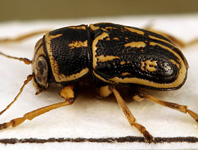Abstract
The gracillariid genus Triberta gen. nov. (Lepidoptera: Gracillariidae: Lithocolletinae Stainton, 1854) is described to accommodate two species formerly assigned to the genus Phyllonorycter Hübner, 1822: Triberta helianthemella (Herrich-Schäffer, 1861) comb. nov. and T. cistifoliella (Groschke, 1944) comb. nov. Triberta cistifoliella bona sp. is restored from synonymy based on morphological characters. The new genus is biologically associated with the plant family Cistaceae of the order Malvales and is endemic to the Palaearctics. Our molecular analysis of eleven nuclear genes failed to unambiguously place Triberta in the lithocolletine phylogeny, but revealed that this genus is distinct from either clade Phyllonorycter + Cremastobombycia and Cameraria. The distinctiveness of Triberta is also supported by inferred traits in wing venation, micro morphology of the last instar larva, pupa, genital morphology of the adult and life history. A key to the species of Triberta is provided. The interspecific homogeneity in external morphology, coupled with minor differences in genital traits, an apparent narrow specialization on Cistaceae host plants, restricted geographical range and molecular evidence based on multi-nuclear genes jointly suggest that the generic diversification of Triberta is a relatively old phenomenon and driven strongly by host selection.

